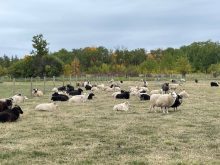There are some 60,000 cow-calf farms and 20,000 dairy operations in Canada. Cattle numbers are around 12.5 million with more than 40 per cent of this total in Alberta. Alberta also had 90 per cent of the beef feedlots with lesser numbers in Saskatchewan and Manitoba. There are 14 million hogs at any time in Canada on 7,600 farms — 40 per cent in Western Canada, with Manitoba having the largest numbers.
On the poultry side, broiler farms number 2,400, turkey outfits at 250 and egg farms at 2,000 or more. Prairie Canada has a total of just over 80,000 individual farms with 41,500 in Alberta, 34,100 in Saskatchewan and 14,700 in Manitoba. The Canadian total is 190,000 farms with many of them horticultural enterprises in British Columbia and Eastern Canada.
Farmed land in Canada totals 160 million acres (65 million hectares) using up 6.3 per cent of Canada’s total land base. Prairie livestock farms produce major amounts of compost along with cities such as Edmonton, Winnipeg and Calgary (organic waste foods) in the hundreds of thousands of tons annually.
Read Also

Managing through market or individual stock declines
Even the best of public-traded companies can periodically experience significant drawdowns, and a successful investor should be prepared to react — or not react — accordingly, Herman VanGenderen writes.
I provided these farmland statistics for an overall view of “manure production” in the whole country but with particular emphasis on Prairie Canada. I made the mistake a few years ago of promoting peat compost for garden soils at a horticultural meeting. Several members of the audience said that Canada was running out of peat. That was until I told them that we had 250,000,000 acres of peat land or 21 per cent of the world supply. They had been reading information from the U.K. where they were running out of peat. I also informed them that peatlands in Canada in drought situations can catch fire and burn for years — wasting millions of dollars of useful peat. Peat is harvested in Canada at one-sixtieth of the rate that it accumulates.
The nutrients in manure, whether nitrogen (N), phosphorus (P), potassium (K), sulphur (S) or micronutrients are no different from bagged fertilizers. Commercial fertilizers are merely concentrations of natural nutrients processed into convenient forms. What manure does over and above its nutrient content is to provide organic carbon matter, which does wonders for all soils. If you need these answers, read the Grainews story “Sixteen reasons why grain growers should never sell crop residues.” I have now upped that total to 20 reasons.
In my field crop disease diagnostic days, I would come across fields of canola that had lodged very badly and were often devastated by sclerotinia. Many of these lodged canola crops were grown on land that was frequently and heavily manured. The heavily manured land was usually owned by dairy farmers or feedlot owners. It seemed that they believed their cropland could be improved with this copious manure without much thought given to soil testing.
The nutrient levels in the tables shown below, in liquid or solid manures, are just broad averages. Storage, animal feed quality and water volume or moisture levels greatly influence nutrient content. If you follow a routine procedure, you can have your liquid or solid manures analyzed for plant nutrient content from which you can use to calibrate your given crop’s target yield requirements.

Those lodged canola crops that I mentioned earlier look very well at the pre-bloom stage — green with a very dense canopy. In one specific field, I estimated that it would go to 80 bushels. At harvest, this quarter field was totally lodged and after combining yielded a measly 27 bushels of canola with masses of black sclerotinia sclerotes.
When canola crops lodge in dense canopies, this white mould fungus easily moves from stem to stem through touching in the lodged canopy as well as in the drying swath. At the top of this fully lodged field there was around five acres of the canola crop that had been heavily damaged by manure trucks. The canola plants that survived the truck wheels were, perhaps, one per square metre or square yard or so. These canola plants grew eight feet tall and bushed out as much as five to six feet in diameter. There was no disease or lodging.
I did not get the final exact result, but this area was said to go 50 to 60 bushels with no disease. What was the problem with this field? Soil analysis showed around 600 pounds of available nitrogen in the top 24 inches. A classic example of overfertilization that had accumulated over many years.
Cereal crops and manure
When it comes to cereal crops and manure, I have seen a completely different story. The fact-finder took lots of time to prove with much help from colleagues to get the right answers.
Take cropland, especially sandy soil types, and put on 10 tons an acre of feedlot or dairy manure in the fall. You then seed this land to wheat or barley the following spring. You did not do a soil test, but you guessed that you added about 70 to 100 pounds of nitrogen as well as the phosphorus, potassium and sulphur in the manure.
Your wheat looks good in June but by late July it’s hopelessly lodged. You and your neighbours say that it’s too much nitrogen. Wrong. What has likely happened is had you done a soil test you would have had about 10 to 20 pounds of available nitrogen and at four per cent organic likely up to 40 pounds more nitrogen in the season. The elephant in the room is the 10 tons of carbohydrate in the manure. When this manure is added to your cropland, billions of starving fungi, bacteria and other micro-organisms feed on this carbohydrate source.
They get first dibs on the nitrogen, phosphorus, potassium, sulphur and micronutrients. Up to 30 per cent of Prairie soils are low to deficient in copper. What has copper got to do with this? The soil micro-organisms also grab up the soil micronutrients, especially the available copper. The wheat or barley plants cannot now make stem lignin that holds up the plant. The result? Severe lodging and major yield loss. Copper is essential for lignin formation for stem strength, especially in wheat and barley. I know this may confuse or contradict your beliefs but it’s fact. You will also see ergots, another sign of copper deficiency.
You could have prevented lodging in that 10-ton-per-acre feedlot manure application by doing the following:
- Add about 80 to 100 pounds of nitrogen that spring for a 50- to 60-bushel wheat crop.
- Apply around five pounds an acre of actual copper in the form of sulphate (good for 10 years).
- Apply foliar copper at early wheat stem elongation and again at the flag leaf stage.
I would love to debate these facts on manure and wheat lodging anytime, anyplace.
Lodging is a lot worse in wet growing conditions than in dry years since under wet conditions the crop roots stay near the soil surface where micronutrients are most deficient. In dry years, cereal roots go down into the soil three feet (one metre) or more where micronutrients are much more available, thus preventing lodging.
If wheat or barley had been planted on that first field with 600 pounds of available nitrogen per acre, they would have now lodged from excessive nitrogen for sure. Very heavy nitrogen rates do interfere with lignification. So says Horst Marschner in his famous textbook, Mineral Nutrition of Higher Plants.
Please download and read Alberta Agriculture’s Agri-Facts fact sheet “Copper Deficiency: Diagnosis and Correction,” Agdex 532-3.
Some food for thought: I have learned that when individuals chose to ignore the facts it does not change the facts.















